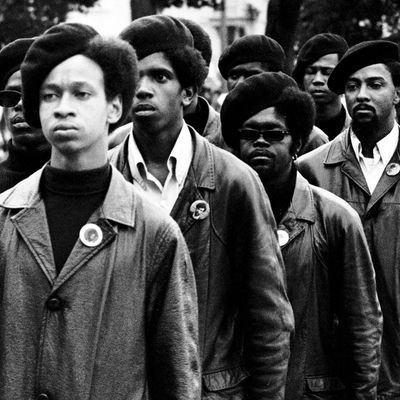
Stanley NelsonÔÇÖs new documentary about the Black Panther Party is admirably sober, but it nevertheless evokes great urgency and passion. Using archival footage and interviews ÔÇö with historians, with the Panthers themselves, and with the cops who pursued them ÔÇö it brings to life a still-contentious historical moment and, without too much insistence or obviousness, artfully draws parallels with today. Watching it, we recognize that the things the Panthers fought against remain a part of our society. Whether thatÔÇÖs a testament to the quixotic nature of their project, or just a sign that more work needs to be done, is up to us to decide.
Though the period heÔÇÖs tackling lasts only about a decade ÔÇö from the groupÔÇÖs formation in 1966 by activists Bobby Seale and Huey P. Newton, through to its fragmentation in the mid- to late-70s ÔÇö Nelson (Freedom Riders, Jonestown: The Life and Death of Peoples Temple) has to cover a lot of ground. In part, thatÔÇÖs because the PanthersÔÇÖ own legacy is up in the air. Their drawing power came not just from the outrage against the injustices they were fighting, but also in the dashing figures they cut. As one female Panther observes, there was something just┬ácool┬áabout the look ÔÇö the big Afros, the leather jackets, the shades ÔÇö that captured the imaginations of both black and white people. The Panthers understood the power of ÔǪ well, power. This was a movement, after all, that first gained widespread notice when Seale and others found themselves on the floor of the California State Assembly with rifles slung over their shoulders, advocating for their Constitutional right to bear arms. Nobody had seen anything like that before; that Seale and Newton were so well versed in California law, and knew exactly the limits of their rights, made them all the more impressive. (Watching the film, you could get the taboo idea that the Panthers may have inspired some in the tea party as much as they inspired those in movements like Black Lives Matter.)
But thereÔÇÖs also a broader historical arc to cover here. As one interviewee makes clear, the period immediately preceding the PanthersÔÇÖ formation saw dozens of countries around the world achieving independence; it was a revolutionary time, when the institution of the state was increasingly questioned. Beyond that, the Panthers worked as a counterpart, or complement, to the Civil Rights movement, which focused primarily on southern issues like segregation and voting rights. The Panthers articulated an angry and eloquent rebellion around things like housing, employment, social services, and wealth ÔÇö issues that resonated in the urban centers of the North. ThatÔÇÖs probably partly why FBI director J. Edgar Hoover was so obsessed with them. It may seem outrageous to see him calling the Panthers the No. 1 threat to American national security at the height of the Cold War, when we were still embroiled in Vietnam, but on some level, he had a point. Simply by confronting the realities behind American prosperity and power, and helping lay bare the injustices on our streets, the Panthers struck a chord that those outside the U.S. could not.
And the Panthers practiced what they preached, too, providing important social services like breakfasts to inner-city children and free clinics in impoverished neighborhoods ÔÇö efforts the group called ÔÇ£survival programs,ÔÇØ with all the urgency that suggests. Indeed, the film explains that this was one cause of the eventual rift between two of the groupÔÇÖs charismatic leaders ÔÇö the increasingly paranoid Newton and his fugitive minister of information Eldridge Cleaver, who was hiding out in Algeria while picking at his fellow PanthersÔÇÖ focus on social services instead of ÔÇ£overthrowing the American government.ÔÇØ To its credit, though, the film doesnÔÇÖt allow itself to be overwhelmed by these cults of personality. While itÔÇÖs impossible to tell the story of the Black Panthers without telling the stories of men like Cleaver, Seale, and Newton, NelsonÔÇÖs film also offers a look at the ground troops ÔÇö many if not most of them women ÔÇö who did the hard work of organizing protests, raising money for legal defenses, and helping rebuild broken communities.
Could the Panther movement have survived? Could it have achieved lasting, real change, or ÔÇ£gone legitÔÇØ? The filmÔÇÖs most impassioned moments come in its depiction of two events that had a tangible effect on the partyÔÇÖs future: the police murder of Fred Hampton, the charismatic 21-year-old Panther leader in Illinois who seemed to embody HooverÔÇÖs fears of a ÔÇ£black MessiahÔÇØ rising from their ranks; and the epic campaign of Seale to be mayor of Oakland, an ultimately unsuccessful political effort that nevertheless registered many thousands of African-American voters.
No doubt,┬áBlack Panthers┬áwonÔÇÖt be for everybody. Despite NelsonÔÇÖs efforts at balance, this is a largely admiring portrait, and there will be those who wish the film focused more on the PanthersÔÇÖ less savory actions and cases. But the film is also refreshingly clearheaded about the limits of idealism and provocative action. ÔÇ£The great strength of the Black Panther Party was its ideals, and its youthful vigor and enthusiasm,ÔÇØ says one interviewee. Then he adds, with a bitter laugh, ÔÇ£And the great weakness of the party was its ideals, and its youthful vigor and enthusiasm.ÔÇØ


